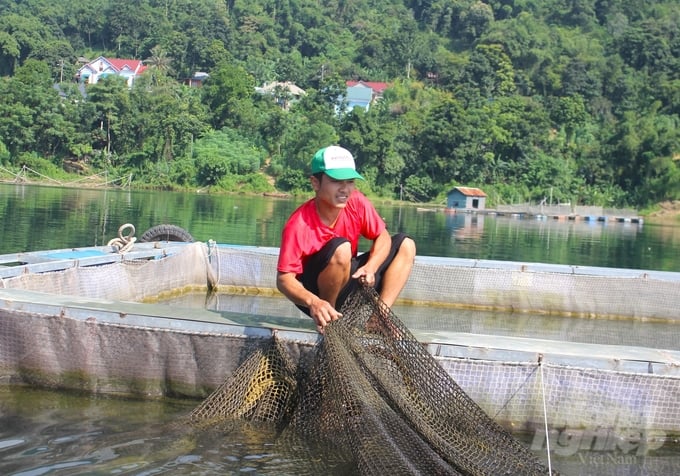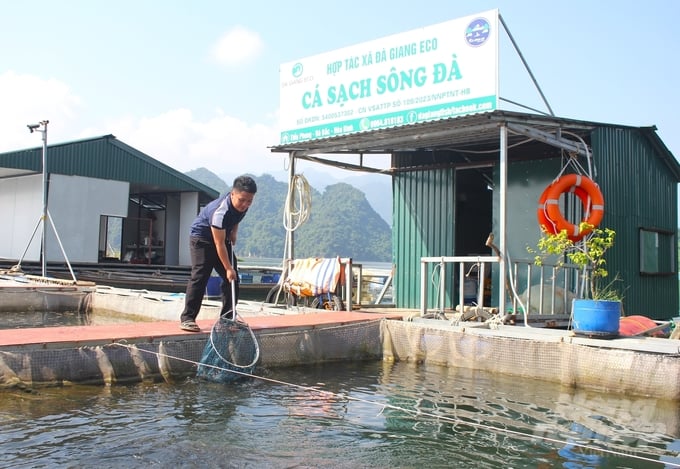November 23, 2025 | 04:42 GMT +7
November 23, 2025 | 04:42 GMT +7
Hotline: 0913.378.918
November 23, 2025 | 04:42 GMT +7
Hotline: 0913.378.918

In Da Bac district, lake fish farming households have invested in upgrading facilities, forming chain links... to improve production efficiency. Photo: Trung Quan.
With the advantage of having over 7,000 hectares of water surfaces in hydropower reservoirs, in recent years, Da Bac district (Hoa Binh) has implemented a comprehensive set of solutions to develop aquaculture in the lake area to contribute to creating employment opportunities and sustainable poverty reduction for the ethnic minorities in the region.
According to the Department of Agriculture and Rural Development in Da Bac district, from a small number of households and fish cages that could be counted on one hand, the district now has more than 1,000 fish cages, with an annual average production of over 1,000 tons concentrated in the communes of Hien Luong, Vay Nua, and Tien Phong.
To maintain the "Da River – Hoa Binh" fish brand, increase economic efficiency, and minimize environmental pollution, households have invested in upgrading physical infrastructure, adopted advanced farming practices, formed value chains, and integrated production with tourism development.

According to Mr. Xa Ngoc Hung, Director of Da Giang Eco Cooperative, in order for lake aquaculture and aquaculture activities to develop, households must solve many "problems" at the same time. Photo: Trung Quan.
In Tien Phong commune, Mr. Xa Ngoc Hung, Director of Da Giang Eco Cooperative, Dieng Lung hamlet, Tien Phong commune, shared that the cooperative, consisting of 10 members with 40 cages for catfish and snakehead fish farming, achieves an average yield of 7-8 tons per cage per cycle.
To ensure product quality, the cooperative has established common technical care procedures (stocking density, feed mixing, etc.) and adheres to principles such as using reputable breeding stock and feed sources, avoiding excessive antibiotic use, maintaining comprehensive records of the care process, and implementing cross-household monitoring and management.
According to Mr. Hung, developing aquaculture in reservoirs has several advantages, such as a large water surface area, and water sources with minimal impact from domestic sewage, livestock waste, agriculture, and industry. Additionally, there is an abundant local food source available, including corn, potatoes, cassava, grass, fish, shrimp, and more, which helps reduce food costs and increase the quality and selling price of products for the farmers.
However, to make this activity truly effective, farmers must simultaneously solve several "challenges" like the significant initial investment costs (approximately 90-100 million VND per cage), complete dependence on natural water sources, making the management, protection, and harvesting of aquatic products difficult, and dealing with unstable market demand.

Mr. Dang Minh Vuong, Tup hamlet, Tien Phong commune, said that if the State, scientists, and businesses cooperate, cage fish farming households will be more confident. Photo: Trung Quan.
Mr. Bui Van Anh, Vice Chairman of the People's Committee of Tien Phong commune, stated that the whole commune has nearly 800 fish cages with 400 participating households. Previously, the income of the local people relied mainly on crops like corn, cassava, and a few low-efficiency forest plantations. Since the cage fish farming business was formed and developed, it has significantly improved the daily lives of the residents, with the average income per person in the commune rising to 34 million VND per year.
According to Mr. Anh, the potential for developing aquaculture in the lake area, combined with experiential tourism, is substantial not only for Tien Phong but also for other communes in the district. This is a direction that requires comprehensive investment and development. In the near future, the commune is planning to expand the types of aquaculture according to market demand, alongside traditional aquaculture practices. Furthermore, they aim to encourage the formation of cooperatives, production groups, and supply chains to ensure a sufficient supply of products, product quality, information transparency, and convenient marketing.
Mr. Dang Dinh Vuong, from Tup hamlet, Tien Phong commune, who operates 14 fish cages, believes that while the advantages and potential of aquaculture in the lake area are evident, for every household to have the opportunity to "change their lives," there needs to be more specific support policies from state management agencies (such as planning, licensing for using water surfaces for aquaculture, and favorable access to loans), and involvement from businesses (including product procurement and processing).
Only then will the people truly have peace of mind in their production efforts. He also stressed the importance of shared experiences, the courage to invest and borrow, diligence, and hard work, but noted that fish cage farming is like gambling, and a small mistake can result in significant losses. Therefore, with the support of the state, scientists, and businesses, fish farmers can be more confident.
Translated by Linh Linh

(VAN) Viet Nam’s forestry sector is undergoing a comprehensive transformation, strengthening management, protection, and development efforts to maintain ecological security and drive green, sustainable growth.

(VAN) Viet Nam is accelerating efforts to digitize reservoir operations, from real-time data to hydraulic modelling.
/2025/11/21/3348-2-102623_454.jpg)
(VAN) National Assembly delegate Nguyen Thi Lan has proposed adding special mechanisms to attract human resources to the agricultural, forestry, and fishery sectors, addressing the shortage of high-quality personnel.

(VAN) Over the past two decades, the unified legal framework for water resource management has been perfected, becoming a crucial foundation for ensuring national water security.

(VAN) The land-data cleansing campaign in Dien Bien is entering its final stretch, yet weak infrastructure, limited personnel and fragmented multi-period datasets continue to create major obstacles.
/2025/11/20/0204-2-115235_496.jpg)
(VAN) Not only do carbon credits bring a great revenue source, but they also contribute to better forest protection and development. However, this potential remains largely untapped.

(VAN) Applying modern technology is helping environmental monitoring and oversight of management quality.